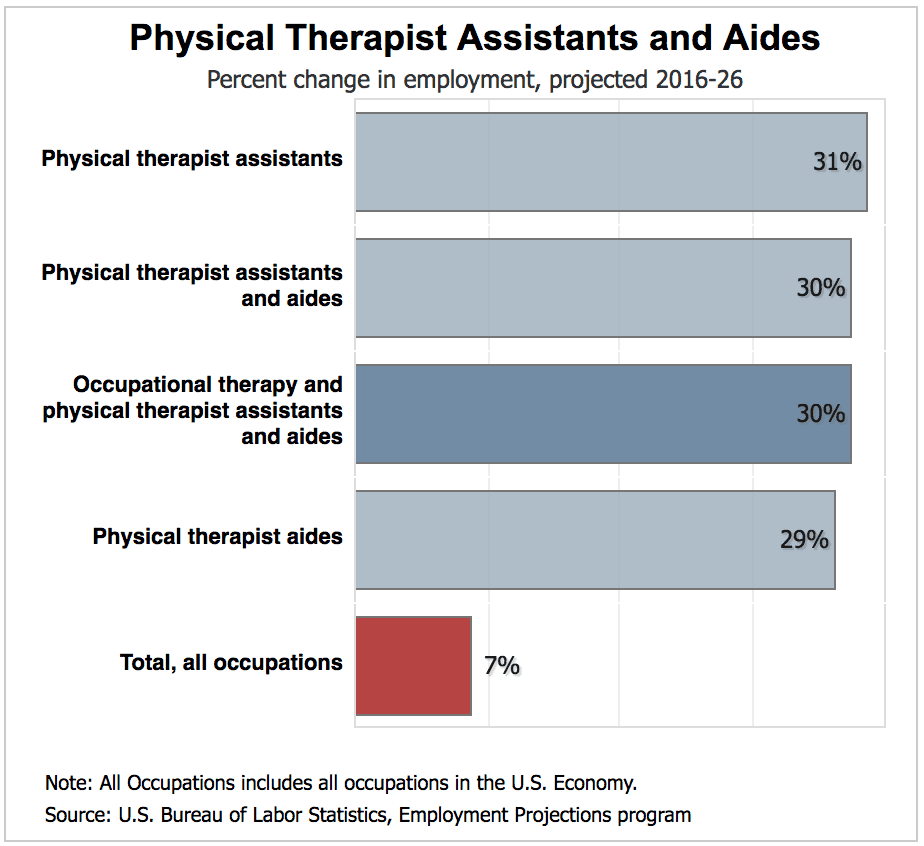Page Contents
There are not too many occupations today that deserve bragging rights more than the physical therapists and physical therapist assistants.
Ok maybe not bragging rights, but when it comes to job satisfaction, Physical Therapy jobs hold their own.
A career in physical therapy holds top rankings on CNN Money’s list called Best Jobs For Top Growth in addition to the US News list of 50 Best Careers.
Also, ask any physical therapist or PTA and they will tell you that they spend their time working in one of the most enjoyable jobs of all.
So, it comes as no surprise that many people are interested in becoming a physical therapist assistant and asking if they should become a PTA.
How positive is the physical therapy assistant job outlook?
Are there plenty of physical therapy employment opportunities?
Today we will provide some physical therapy employment data to provide a clear answer.
Beyond job satisfaction, we will look at employment and salary statistics.
So, if you are interested in going to physical therapist assistant school, or are about to graduate then this should help you understand your career outlook.
Without further ado, let’s see what the physical therapy assistant job outlook is looking like.
A Positive Physical Therapy Assistant Job Outlook
Not only are Physical Therapy jobs great, they are in high demand.
You can actually look at the job demand statistics to form a strategy for finding your next job, which is what we will show you how to do in this article.
Taking a quick look into the crystal ball (Data from the Bureau of Labor Statistics) shows that outpatient physical therapists can expect a huge 31% or more when it comes to growth in jobs over the next decade (through 2026).
This is higher than the average compared to most other occupations.
In both today’s job market and far into the future, individuals looking for a job position working as a physical therapist, physical therapist aide or physical therapy assistant should feel quite optimistic about their prospects.
However, the trick is finding and actually landing that dream job!
New Places Where Physical Therapists Work
Looking closer at physical therapist job growth shows that more new jobs are going to be added in some segments of the healthcare industry than in others.
So the highly promising job growth won’t take place across each segment of healthcare.
Therefore, physical therapists following the growth trends and using projections as leverage when looking for a job will most likely be able to capitalize on the positive outlook of the occupation.
There are many different places a PT and physical therapist assistant work.
A strategy can be devised to achieve this from the details that the Bureau of Labor Statistics offers.
The chart below depicts the total number of physical therapists that are currently employed (blue columns) over six segments of the healthcare industry compared to projected increases by 2026 (red columns). These are listed in order according to how many physical therapists are currently employed.
The charts show that there are more physical therapists (67,100) that are currently employed in offices that provide physical, speech and/or occupation therapy compared to all other healthcare segments.
What is even more worth noting and prominent is that it indicates that this is the segments that also is projected to experience the highest job growth for physical therapists (54%).
It can be concluded by viewing the chart that job openings are currently, and will continue to be for the rest of the decade, more plentiful in therapy offices than anywhere else.
Projections for other segments in the healthcare industry, however, offer less obvious conclusions that can be drawn.
Although private and public hospitals currently employ as many as 58,000 physical therapists, this segment of healthcare is projected to experience job growth of less than 12% through 2026 for physical therapists.
That is much lower than the 47% job growth projections for the home health care segment, that currently employs around 21,000 physical therapists.
In addition, although there are almost double the number of self-employed physical therapists compared to those working in physicians offices, the former projects job growth of just 5% through 2026, while the latter’s project job growth is at 34%.
In other words, although many physical therapists are self-employed and work at hospitals currently, those two segments of the healthcare industry are not expected to add as many jobs through 2026 as some of the more favorable projections seen for nursing care facilities, physicians offices and home health care services.
| Employers | Projected Growth by 2026 |
|---|---|
| Offices of Therapists | 54% |
| Home health care services | 47% |
| Office of physicians | 34% |
| Nursing care facilities | 25% |
| Hospitals public and private | 12% |
| Self-employed workers | 5% |
Above there is a table highlighting the job growth percentage that is expected for physical therapists over six healthcare segments. In this table the order they are listed in is by projected job growth percentage.
One thing to note is, with the exception of therapist offices, the order of information is completely different from how the information was displayed in the earlier chart. The differences illustrate how what is common today might not be in future years.
Physical Therapy Employment Data Shows Opportunities
Keeping track of projected trends for job growth can be a very effective strategy for those looking to start new physical therapy careers in future years, particularly student physical therapists.
There are certain vital healthcare industry segments that might offer unique opportunities for physiotherapists or rehabilitation technicians.
In addition, for physical therapists that are experienced and want to pursue advancement opportunities, being able to identify the healthcare settings that have the greatest demand could help increase the chances of success.
Rather than researching job ads online and in newspapers or phone books, do some research into the different healthcare segments that physical therapists and PTAs are employed in.
You are likely to identify job opportunities that you hadn’t considered or would have never found while reviewing job advertisements and online postings.
Look into some of the following options:
- Physical therapy clinics – general practices covering disease and injury rehabilitation
- Sports clinics & athletic programs – College, High School, Private
- Nursing care facilities – work on site as a physical therapist or PTA serving patients
- Elderly care – nursing homes, private home health care, assisted living homes
- Private and public hospitals – these can be small or large local hospital clinics
- Your own business – can you serve a market in your region?
This post share many more ideas for places PT and PTA can work, for example they can even work in schools.
Growing Demand for Physical Therapy Services
All of this data makes a compelling case for the profession of physical therapy.
You’ve probably realized that the job outlook on physical therapy is great.
There’s no reason not to capitalize on the upsides of getting trained in a career that is in high demand.
An aging population is creating increased needs for rehabilitative services far into the future, which should make physical therapists feel very optimistic about job growth prospects.
The anticipated 31% + job increase will offer many excellent opportunities for therapists.
However, job seekers who are knowledgeable about where the highest growth is taking place will definitely be at an advantage. Jobs will definitely be available.
The question is how physical therapists can obtain the highest rewards in a career that offers so much.
Physical Therapy Assistant Salary Outlook
Job satisfaction, a growing demand, and a variety of advancement opportunities are very important factors to consider in choosing an occupation.
But as they say, money talks.
And when it comes to choosing your career, you certainly want to know your salary potential.
The good news is that PT and PTA salaries are very competitive. So, not only are these positions highly satisfying with plenty of growth opportunities, they pay well too!
The average annual PT Salary is $89,420 while a PTA earns $64,510 on average annually.
Compared to other healthcare professions that have similar education and licensing requirements, these salaries are very competitive.
Over to you
If you are a physical therapist who is looking for work currently, test out the strategy from this article.
See if you can locate more job openings inside the healthcare segments that you had not thought to look in before and see what trends you happen to notice.
And don’t forget to use our handy tools to search for PTA jobs and PTA Licensing Applications.
Tell us in the comments below how your physical therapist or physical therapy assistant job outlook is. 🙂




Leave a Reply